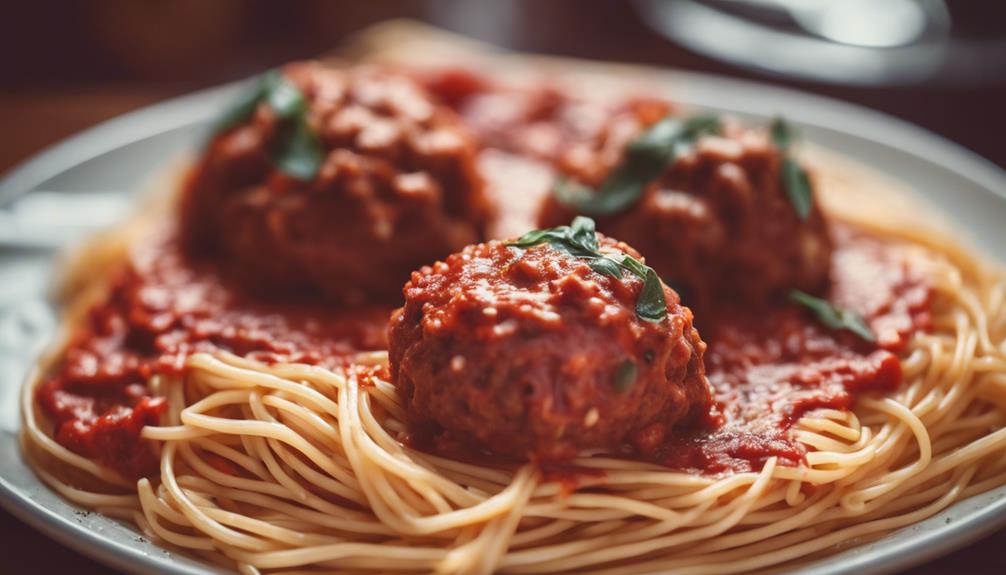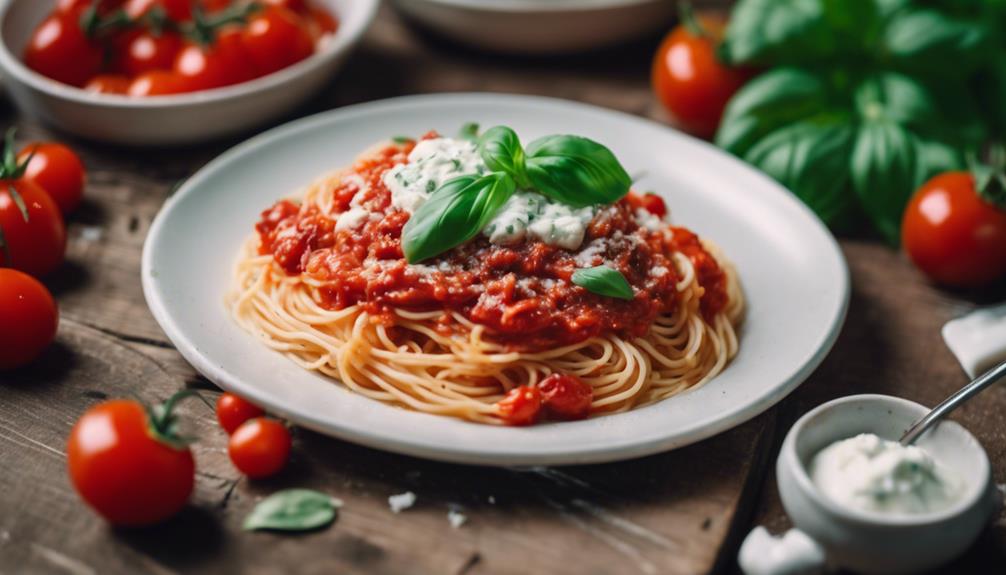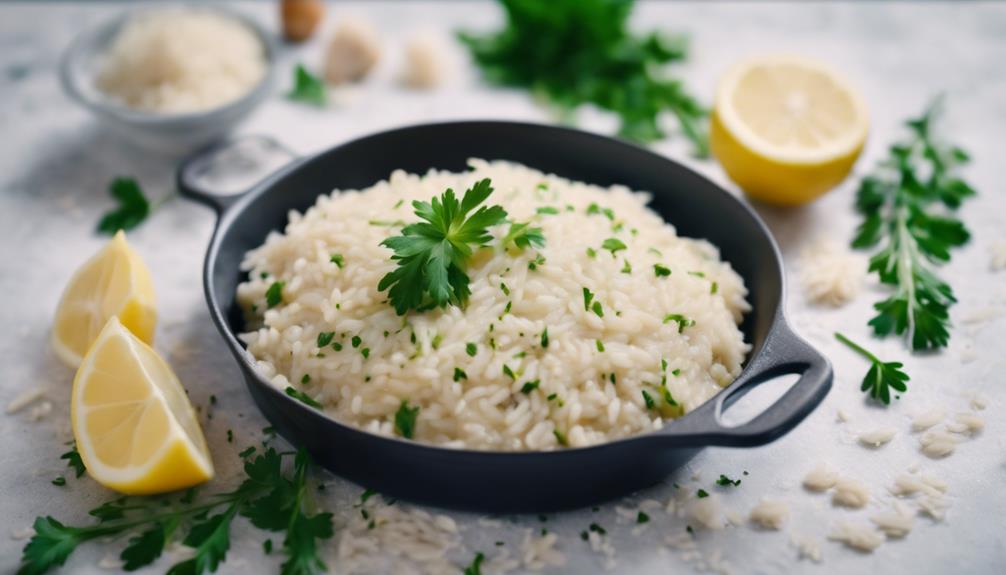Discover the taste of Italian cuisine without dairy! Don’t worry, there are plenty of delicious options available. Indulge in pasta dishes made with olive oil and vegetable toppings, or try out creamy vegan alternatives like cashew cream. Don’t pass up on tomato-based sauces or flavorful pesto. Try dairy-free pizza with fresh basil or plant-based cheese such as Daiya. Risotto lovers can enjoy vegan versions with mushroom or butternut squash. Treat yourself to dairy-free soups like Minestrone packed with fresh vegetables. Delight in dairy-free salads like Panzanella with a unique twist. And of course, don’t forget about dairy-free desserts like tiramisu or citrusy sorbet. Explore Italian dairy-free beverages to complete your satisfying dining experience!
Key Takeaways
- Italian dairy-free dishes include pasta with tomato-based sauces and vegan cheese.
- Creamy alternatives like cashew cream and coconut milk enhance Italian recipes.
- Dairy-free options in Italian cuisine range from risotto to pizza and desserts.
- Olive oil, herbs, and vegetable-based sauces provide dairy-free flavor in Italian cooking.
- Italian restaurants offer dairy-free pasta, pizza, risotto, and dessert options.
Dairy-Free Pasta Dishes
How can you enjoy delicious Italian pasta dishes without dairy? If you're vegan or lactose intolerant, fear not! Italian cuisine offers a plethora of dairy-free options that are just as scrumptious.
Olive oil, tomato-based sauces, and vegetable toppings add depth and richness to dairy-free pasta dishes. For those craving creamy sauces, vegan alternatives like cashew cream, tofu ricotta, and dairy-free cheese are excellent substitutes.
By simply omitting cheese and cream, traditional Italian pasta recipes can easily be transformed into dairy-free delights.
When dining out, many Italian restaurants are now catering to dairy-free needs by offering specific menu items or accommodating special requests. With a little creativity and the right ingredients, dairy-free Italian pasta dishes can be just as flavorful and satisfying as their dairy-laden counterparts.
Italian Dairy-Free Sauces
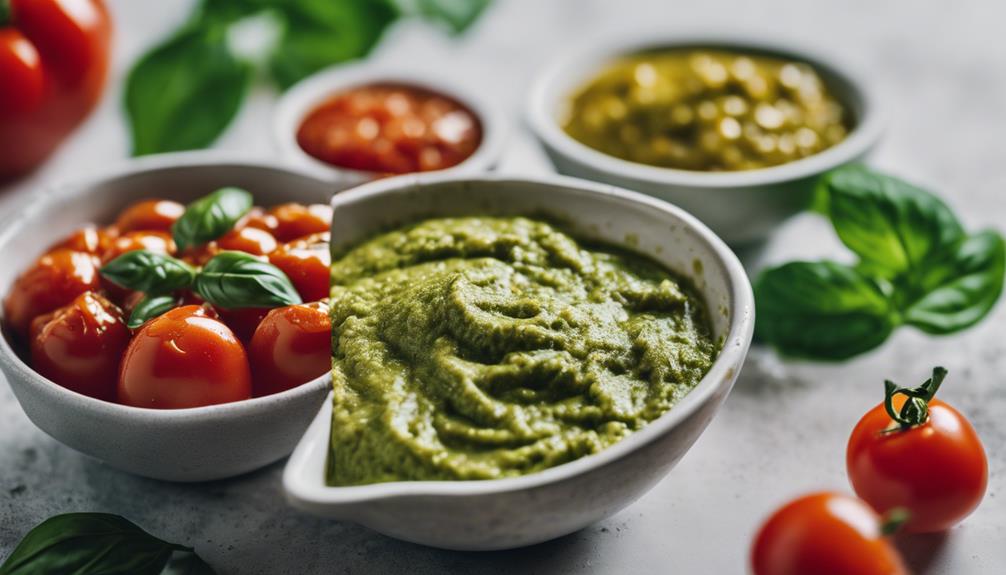
Looking to add creamy dairy-free alternatives to your Italian dishes? Explore traditional sauce variations like tomato-based marinara, arrabbiata, and puttanesca sauces.
Delight your taste buds with olive oil and herb-based options such as pesto, or indulge in a rich vegan vodka sauce made with dairy-free alternatives like cashew cream or coconut milk.
Embrace the flavors of Italian cuisine without milk, and experiment with dairy-free roasted red pepper sauces or the depth of balsamic reduction for a delicious twist to your meals.
Creamy Dairy-Free Alternatives
For creamy dairy-free Italian sauces, consider incorporating cashew cream, coconut milk, or almond milk as alternative bases. These substitutes can provide a rich and velvety texture to your dishes without the need for dairy.
When making Minestrone Soup, opt for a dairy-free base like vegetable broth or olive oil to enhance the flavors of the vegetables and herbs.
Cashew cream can be a great addition to creamy tomato sauces, adding a luxurious and smooth consistency.
Coconut milk works well in curries and creamy pasta sauces, infusing a subtle tropical flavor into your Italian-inspired dishes.
If you're looking for a cheesy taste without dairy, nutritional yeast can be sprinkled into your sauces for that savory kick.
Remember, non-dairy milk such as almond, soy, or oat milk can be seamlessly substituted in your favorite Italian recipes without compromising on taste or creaminess.
Experiment with these creamy dairy-free alternatives to elevate your Italian cooking to a whole new level!
Flavors Without Milk
Consider exploring the diverse array of Italian dairy-free sauces that burst with flavors without the need for milk or cheese. When it comes to vegan garlic sauces, Italian cuisine offers a tantalizing selection. From the zesty marinara to the fiery arrabbiata and the simple yet satisfying aglio e olio, these classics showcase the richness of garlic, herbs, and tomatoes without any dairy additions.
For a nutty twist, pesto sauces made with basil, pine nuts, olive oil, and of course, garlic, bring a burst of freshness to your pasta dishes. Branch out to dairy-free delights like pasta primavera, puttanesca, and cacciatore, where the flavors of the Mediterranean shine through without the need for milk-based ingredients.
If you find yourself in Italy, don't fret about dairy restrictions – many Italian restaurants can whip up olive oil-based dishes packed with fresh ingredients to satisfy your dairy-free cravings. Enjoy the bold flavors of Italian cuisine sans dairy with these delectable vegan garlic sauces.
Traditional Sauce Variations
Explore the rich and diverse world of traditional Italian dairy-free sauces that utilize ingredients like olive oil, garlic, tomatoes, herbs, and vegetables to create flavorful culinary masterpieces.
While classics like marinara, arrabbiata, aglio e olio, and pesto (minus the cheese) are dairy-free staples, there are also unique variations like butternut squash sauce that add a creamy texture without any dairy. These sauces burst with Mediterranean flavors and are perfect for coating pasta or topping grilled vegetables.
If you're looking for a different twist, consider exploring wine-based sauces such as marsala or piccata, which aren't only dairy-free but also add depth and complexity to your Italian dishes.
Tomato-based options like pomodoro or puttanesca are other dairy-free alternatives that pack a punch with their robust flavors. Don't hesitate to experiment with dairy-free alternatives like cashew cream or nutritional yeast to recreate the creamy textures typically associated with dairy-based sauces.
Embrace the creativity and versatility of Italian dairy-free sauces to elevate your culinary adventures.
Dairy-Free Pizza Options

Looking to enjoy a cheesy pizza without the dairy? Fear not! Cheeseless pizza varieties, plant-based cheese substitutes, and custom dairy-free toppings are here to save the day.
Say goodbye to lactose woes and hello to a delicious slice of dairy-free pizza paradise!
Cheeseless Pizza Varieties
Explore a world of flavorful toppings and creative combinations with cheeseless pizza varieties, offering delicious dairy-free options for your next Italian dining experience. When opting for cheeseless pizzas, you can enjoy a unique twist on traditional Italian cuisine while accommodating your dairy-free needs.
Here are some key points to explore:
- Dairy-free pizza options are widely available at Italian restaurants and pizzerias, providing a tasty alternative for those avoiding dairy products.
- These pizzas are often loaded with an array of toppings such as fresh basil, roasted vegetables, olives, artichokes, and dairy-free pesto, ensuring a burst of flavors with every bite.
- The dairy-free pizza crusts are crafted using simple ingredients like flour, water, yeast, and olive oil, guaranteeing a crisp and delicious base for your chosen toppings.
Next time you're craving pizza, explore trying a cheeseless option for a dairy-free Italian dining experience that doesn't compromise on taste or creativity.
Plant-Based Cheese Substitutes
When opting for dairy-free pizza options, consider incorporating plant-based cheese substitutes to enjoy a flavorful and satisfying Italian dining experience without compromising on taste. Plant-based cheeses from brands like Daiya, Violife, and Follow Your Heart offer a range of flavors, using ingredients such as coconut oil, tapioca starch, and nutritional yeast to mimic the traditional cheese texture and taste.
These dairy-free options aren't only suitable for vegans but also cater to individuals with lactose intolerance or those looking to reduce dairy consumption. Many pizzerias and restaurants now provide dairy-free cheese as a substitution, meeting the increasing demand for dairy-free choices.
Custom Dairy-Free Toppings
Consider enhancing your dairy-free pizza experience by opting for custom toppings such as fresh vegetables, olives, and aromatic herbs. When creating a veggie pizza without dairy, you have a world of delicious possibilities at your fingertips. Here are some fantastic options to elevate your dairy-free pizza game:
- Mouthwatering Mushrooms: Add earthy and savory flavors to your veggie pizza with a variety of mushrooms like cremini, shiitake, or portobello.
- Bold and Zesty Onions: Amp up the taste profile of your dairy-free pizza with thinly sliced red onions for a sweet and pungent kick.
- Colorful Bell Peppers: Incorporate a pop of color and a crunch factor by topping your veggie pizza with a mix of vibrant bell peppers in different hues.
These dairy-free toppings not only bring a burst of flavors but also provide a nutritious and satisfying meal that caters to your dietary preferences. Get creative with your veggie pizza and enjoy a dairy-free culinary delight!
Dairy-Free Risotto Varieties
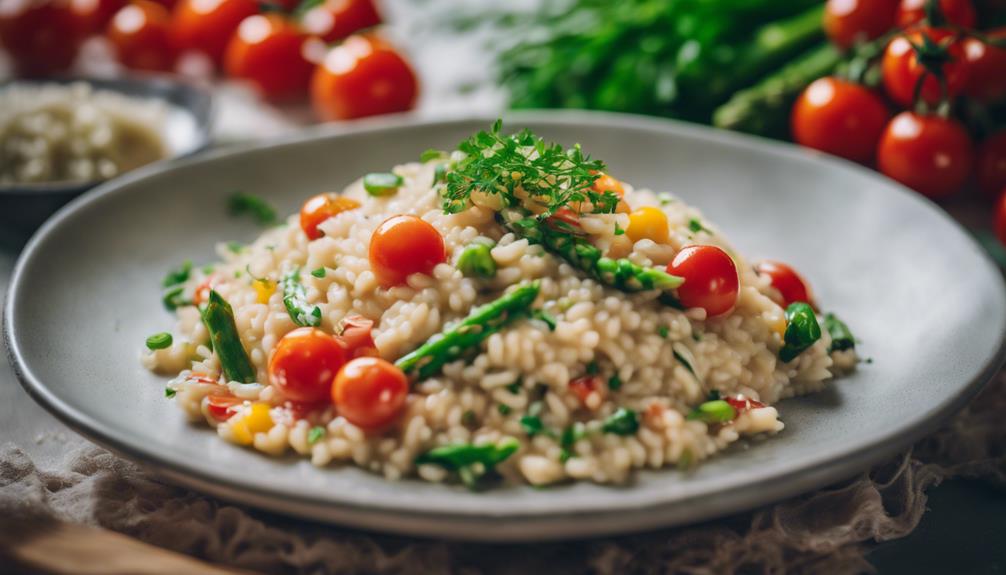
Discover a delectable array of dairy-free risotto varieties that offer creamy textures and rich flavors without the use of traditional dairy ingredients. Whether you're a vegan pasta enthusiast or simply looking to enjoy a dairy-free Italian dish, options like Vegan Mushroom Risotto and Roasted Butternut Squash Risotto are sure to tantalize your taste buds.
The Vegan Mushroom Risotto packs a protein punch with 12g per serving and a satisfying 404kcal, making it a hearty and nutritious choice. On the other hand, the Roasted Butternut Squash Risotto boasts a luscious and creamy texture without a hint of dairy.
Risotto is a versatile dish that lends itself well to dairy-free adaptations. By using alternatives such as vegetable broth and dairy-free butter, you can savor the rich flavors and velvety consistency of risotto without any lactose. These dairy-free risotto options are especially popular among individuals with lactose intolerance or those following a vegan diet.
Dairy-Free Italian Soups
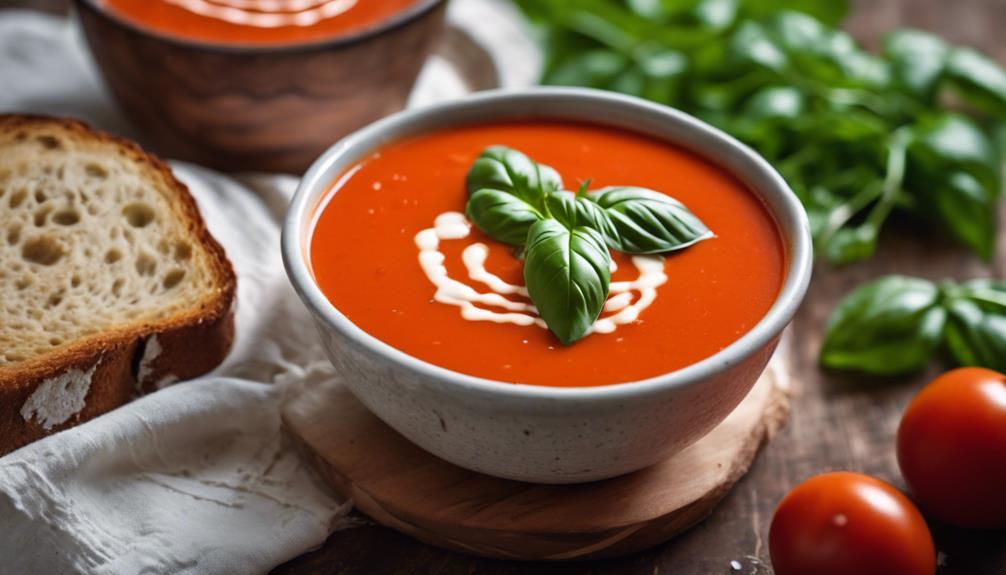
Explore a variety of dairy-free Italian soups that offer flavorful options without the need for traditional dairy ingredients. When you crave a comforting bowl of soup, these dairy-free Italian options will satisfy your taste buds:
- Italian Orzo Spinach Soup: A hearty soup packed with vibrant spinach and orzo pasta, this dairy-free option is perfect for a cozy night in.
- Minestrone Soup: A beloved Italian classic, this soup can be made dairy-free by using a tomato-based broth bursting with an array of fresh vegetables.
- Italian Sausage Orzo Soup: For a twist on a traditional favorite, try this dairy-free soup featuring savory Italian sausage and tender orzo pasta.
Whether you're looking for a light starter or a filling meal, these dairy-free Italian soups are sure to please your palate without compromising on flavor. Enjoy the rich and aromatic tastes of Italy in every spoonful!
Dairy-Free Italian Salads
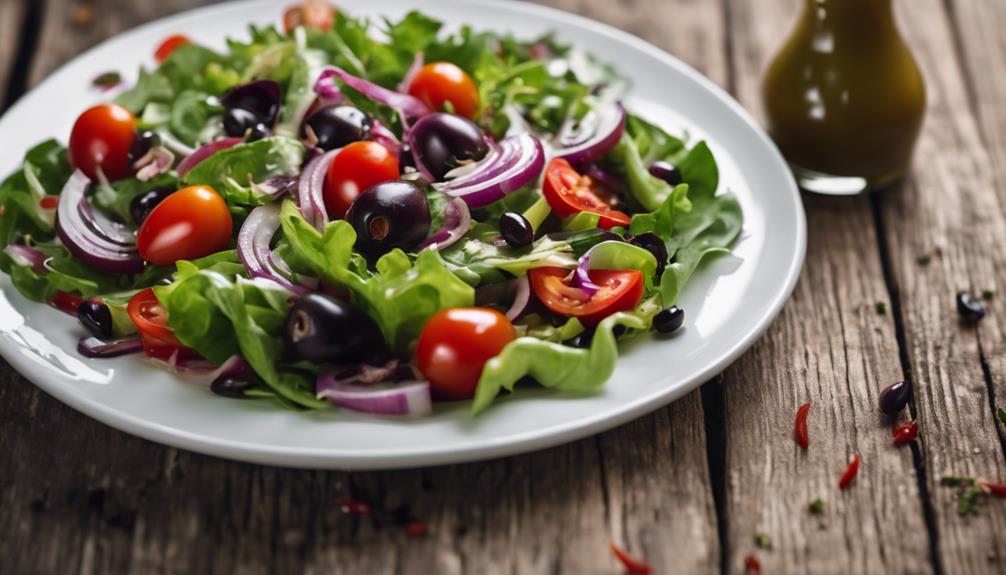
Italian salads offer a delicious dairy-free option that highlights fresh ingredients and simple dressings. From the classic Panzanella with its mix of bread, tomatoes, cucumbers, and herbs dressed in olive oil and vinegar to a dairy-free twist on Caprese salad focusing on ripe tomatoes, basil, olive oil, and balsamic vinegar sans mozzarella, there are plenty of options to tantalize your taste buds.
Mediterranean salads, a staple in Italian cuisine, often feature dairy-free ingredients like olives, cucumbers, red onions, and a zesty lemon vinaigrette. For a peppery kick, try the arugula salad with cherry tomatoes drizzled with balsamic glaze. If you're in the mood for something creamy without dairy, consider adding tofu ricotta for a velvety texture that complements the crispness of the greens.
Italian salads aren't only dairy-free but also bursting with flavors that will make your taste buds sing. Enjoy a dairy-free Italian salad today!
Dairy-Free Italian Appetizers
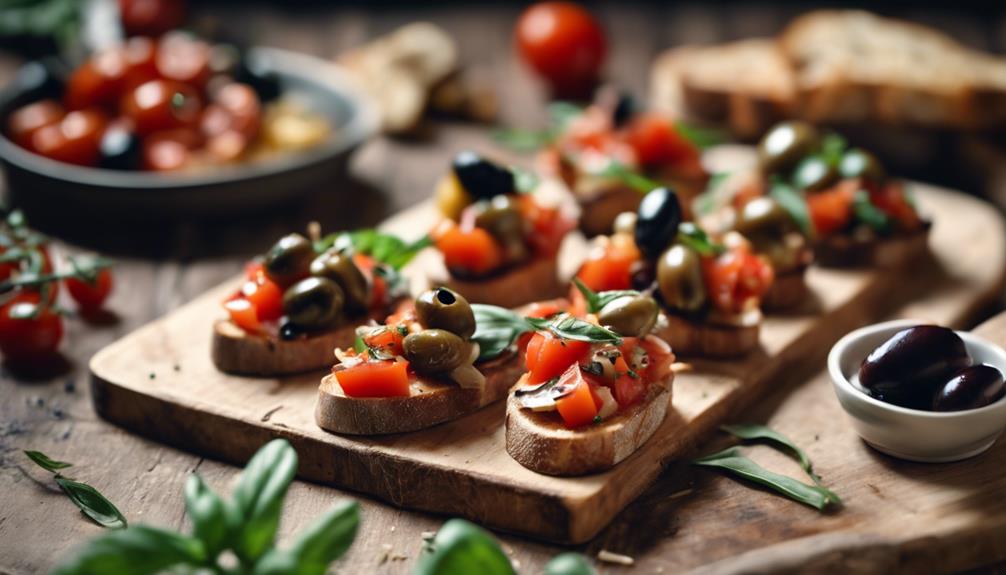
Indulge in a variety of dairy-free Italian appetizers that showcase the rich flavors of Mediterranean cuisine. When exploring dairy-free options in Italian appetizers, you can enjoy a delicious array of flavors while steering clear of dairy products.
Here are some delightful dairy-free Italian appetizers you can savor:
- Socca Pizza: A flavorful chickpea-based crust topped with fresh vegetables and drizzled with olive oil.
- Balsamic Eggplant Steaks: Thick slices of eggplant marinated in balsamic vinegar and herbs, then grilled to perfection.
- Panzanella: A traditional bread salad featuring juicy tomatoes, cucumbers, and basil, all tossed in a tangy vinaigrette.
Italian cuisine often relies on ingredients like olive oil, balsamic vinegar, olives, and honey to create dairy-free alternatives that burst with Mediterranean flavors. Whether you're hosting a gathering or simply treating yourself, these dairy-free Italian appetizers are sure to impress without sacrificing taste or authenticity.
Enjoy the vibrant and aromatic essence of Italian cuisine with these delightful dairy-free options.
Dairy-Free Italian Desserts

Discover a delectable array of dairy-free Italian desserts that tantalize the taste buds with their rich flavors and creamy textures. Italian cuisine offers a variety of sweet treats that are free from dairy, catering to those with lactose intolerance or dietary preferences.
Indulge in dairy-free tiramisu made with dairy-free cream alternatives, giving you the same decadent taste without the lactose. For an invigorating option, try sorbetto or fruit-based dishes like fragrant citrus granita, providing a burst of flavor without any dairy ingredients.
Italian bakeries are also known for their dairy-free offerings, such as crunchy biscotti, delicate amaretti cookies, and fruity tarts that will satisfy any sweet tooth. Gelato shops in Italy may surprise you with dairy-free gelato options, often made with plant-based milks like almond or soy milk.
Embrace these dairy-free Italian desserts and treat yourself to a guilt-free, healthy side dish that doesn't compromise on taste or quality.
Italian Dairy-Free Beverages

Savor traditional Italian dairy-free beverages like espresso, macchiato, and cappuccino crafted with dairy-free milk alternatives for a delightful and authentic taste experience. When in Italy, be sure to indulge in these dairy-free delights:
- Limoncello: This popular Italian liqueur is a zesty treat made from lemon zest, sugar, water, and alcohol, offering an invigorating and dairy-free option for a post-dinner drink.
- Italian Sodas: Quench your thirst with dairy-free carbonated beverages like chinotto and aranciata, infused with fruity flavors such as bitter orange or orange, providing a burst of Italian essence in every sip.
- Granita: Treat yourself to this semi-frozen Sicilian dessert, often dairy-free and bursting with flavors like lemon, coffee, or almond, making it a perfect dairy-free treat to cool off on a sunny Italian day.
Embrace the dairy-free side of Italian beverages and relish the authentic flavors without missing out on the richness of the Italian culinary experience.
Frequently Asked Questions
What Italian Foods Are Dairy Free?
When exploring Italian cuisine, you'll discover numerous dairy-free options like pasta with tomato sauce, grilled meats, and pesto. Remember to request 'senza formaggio' to avoid dairy in cream sauces and cheese-based dishes while dining in Italy.
Are Pastas Dairy Free?
When it comes to pasta, many traditional Italian dishes like aglio e olio and marinara are dairy-free. Some might have cheese or cream, so always check for dairy-free options with the chef.
What Do Vegan Italians Eat?
When you think about what vegan Italians eat, you might picture vibrant dishes like vegan pasta with tomato sauces, flavorful bruschetta, and hearty risotto. Their cuisine is rich in flavor and culture.
Does Pasta Have Milk or Eggs?
Pasta typically doesn't contain milk or eggs in the dough. Some fresh pasta recipes might have eggs, but dried pasta is often egg-free. Always check ingredients when dining out. Stick to tomato-based or olive oil sauces for dairy-free options.
Are There Dairy-Free Options for Traditional Italian Dishes?
Yes, there are dairy-free options for traditional Italian dishes. Many classic Italian recipes can be modified to be dairy-free by using plant-based substitutes like almond milk, cashew cream, and nutritional yeast. With some creativity and knowledge of dairy alternatives, Italian cuisine explained can still be enjoyed by those with dairy restrictions.
Are There Dairy-Free Options in Famous Italian Dishes?
Yes, there are dairy-free options available for famous Italian dishes like pasta primavera, marinara pizza, and olive oil-based bruschetta. These dishes are traditionally dairy-free and are popular among those looking for dairy-free options on the famous italian dishes list.
Conclusion
So, whether you're craving a creamy dairy-free risotto, a cheesy dairy-free pizza, or a decadent dairy-free tiramisu, Italian cuisine has something for everyone.
With a wide variety of dairy-free options available, you can enjoy all the delicious flavors of Italy without compromising your dietary preferences.
So go ahead, indulge in these dairy-free Italian dishes and savor every bite – you won't be disappointed!
Buon appetito!

